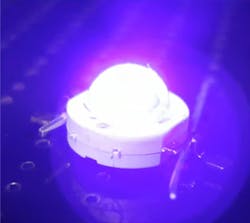Sterilization is a critical preventative measure for staving off healthcare-associated and waterborne illnesses, and it can be achieved by a number of techniques including irradiation using ultraviolet (UV) light. This need has gained greater urgency because of the global coronavirus (COVID-19) pandemic, as effective sterilization practices can curtail the spread of infectious diseases.
Current sources like mercury lamps are bulky, contain toxic chemicals, and are not as versatile in applications as semiconductor light sources. Aluminum gallium nitride (AlGaN) is the material of choice for high-efficiency deep-UV light sources, which is the only alternative technology to replace mercury lamps for water purification and disinfection. To date, however, AlGaN-based mid and deep-UV LEDs exhibit very low efficiency. One of the primary limiting factors is the poor hole injection, due to the ineffective p-type doping of AlGaN alloys using magnesium (Mg), especially for the high aluminum composition alloys that are essential for the UV-C (200–280 nm) wavelength ranges.
A promising technique that can overcome this challenge and enhance hole injection into the device active region is by utilizing a tunnel junction structure. The hole injection in such devices is driven by the interband transport of electrons from the valence band of the p-type layer to the conduction band of the n-type layer.
Professor Zetian Mi’s group at the University of Michigan (Ann Arbor, MI) has performed a detailed investigation of the design, epitaxy, fabrication, and characterization of tunnel-junction UV-C LEDs operating at ~265 nm. The large bandgaps and reduced doping efficiency of AlGaN make it difficult to obtain direct tunneling between the p-type and n-type layers. To overcome this issue, the team has studied unique device designs including a thin GaN tunnel junction layer with different thicknesses, as well as different thicknesses of the top n-type AlGaN.
This technique relies on the large spontaneous and piezoelectric polarization fields of the III-nitrides, which can be manipulated by sandwiching a layer of different material composition in between the doped layers, dramatically increasing the tunneling probability. Moreover, a special metal-semiconductor junction assisted epitaxy method was developed to dramatically improve the Mg doping and hole concentration of Al-rich AlGaN layers.
The optimized tunnel junction device showed much improved current-voltage characteristics as compared to a conventional LED with a p-type AlGaN contact layer. The improved injection in the tunnel junction device translated into stronger electroluminescence, without the presence of any defect emission peaks. The emission was also observed to be extremely stable with little variation in peak position over a broad injection current range. The team has achieved a maximum external quantum efficiency of ~11% and wall-plug efficiency of ~7.6%, providing a viable path to break the efficiency bottleneck of deep-UV photonics.
This study also elucidates the critical role of electron overflow in the efficiency droop observed for AlGaN UV LEDs and will have significant impact on the design and development of high-efficiency deep-UV AlGaN LEDs, which are critical technologies for water/air purification, food preservation, and surface sterilization.
Some IP related to this work has been licensed to NS Nanotech, which was co-founded by Prof. Mi. Full details of the work appear in the journal Photonics Research.
